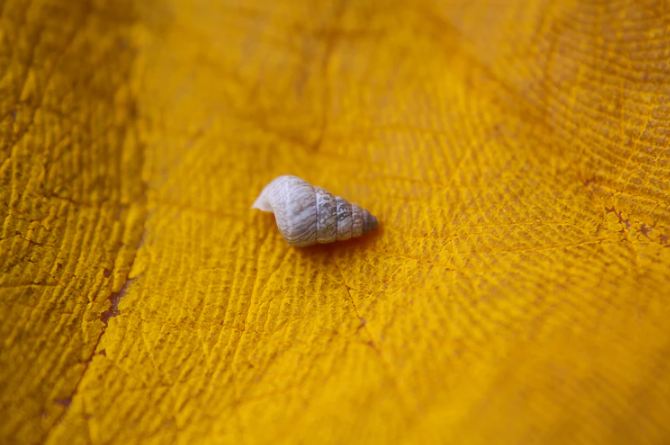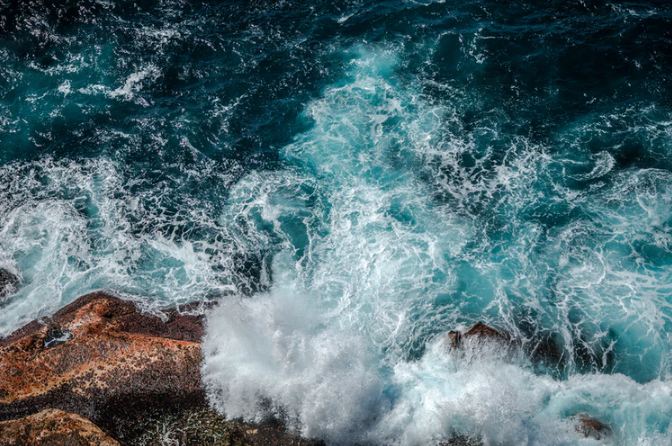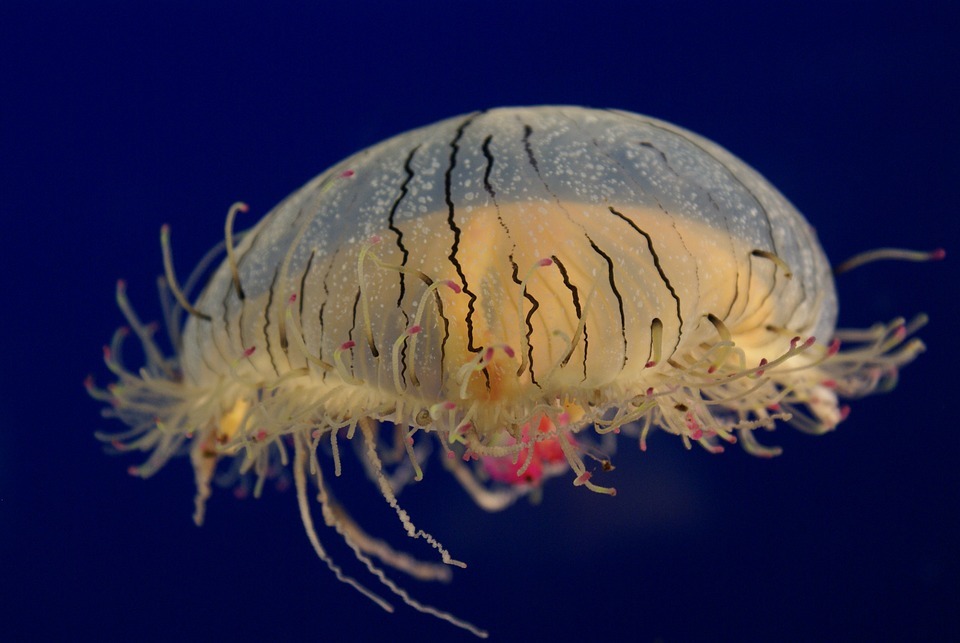Nature boasts a multitude of weird and outright strange creatures. You cannot be blamed for thinking that some of them are not even from earth. One of the most interesting phenomena found in nature is bound to be the ability of some creatures to produce light and glow.
From jellyfish to fireflies, glowworms, and angler fish, etc., many creatures possess bioluminescence capabilities. This unique quality has fascinated scientists for decades. We keep discovering more and more new things about unique creatures around the world.
Clusterwinks are also capable of producing light. These sea snails can create an enchanting view as they flash a bright blue-green light. They are one of the very few sea snail species that can emit light. This makes them one of the more interesting snail species out there.
These beautiful tiny sea snails can look like a child’s night light when they flicker and glow. Knowing this strange ability of this creature, one might wonder how they produce this glow and why they do it. Where are they found, and what is their natural behavior?
Below are answers to some of the questions you might have regarding these little glowing friends of ours.
What are Clusterwink Snails?
Hinea brasiliana, commonly known as yellow-coated clusterwink, is a species of sea snails known to be bioluminescent. They are also quite small, almost the size of the nail of your thumb.
Clusterwink sea snails have a conical shell that tends to be around 0.8 inches long on average. It is also quite heavy and thick. The shell boasts a trapdoor-like lid called an operculum. When the snail retracts its soft parts into its shell, the operculum closes, protecting the snail.
The shell is usually white or yellowish and has a spiral shape. Besides protecting the snail, the shell also diffuses the snail’s light and spreads it all across the shell. It also helps spread the light in every direction.
In the beginning, a yellowish-brown organic coating covers the shell, but it wears away, leaving the shell exposed.
When the snail is observed under normal conditions, its shell appears to be opaque and yellowish in color. This baffled scientists because it seemed that the shell should stifle light transmission, not intensify light like it does. But researchers have found that when the snail emits its bioluminescence, it comes from the body of the snail. What the shell does is disperse only the particular color emitted by the snail, amplifying the snail’s glow and emitting it in all directions.
Where Are Clusterwink Snails Found?
Clusterwinks are commonly found in Australia and New Zealand. In Australia, a great amount of shell debris that washes ashore comprises of shells of dead snails. Although clusterwink sea snails prefer high-energy shores, they avoid exposed shores and those that have too much high wave action.
How do Clusterwink Snails Glow?
It is not common for bottom-dwelling creatures to be able to emit light. Clusterwink sea snail, on the other hand, has a shell that is capable of maximizing the light produced by the snail. Although these sea snails were discovered a long while ago, the scientists were uncertain regarding how they produced light.
Scientists of Scripps Oceanography named Dimitri Deheyn and Nerida Wilson studied this species of sea snails. What needs to be understood is that although clusterwink sea snails are not very well known, they still held a certain mystery to them. So, these two scientists went out to unravel this mystery, and they would go on to discover something fascinating.
It was known that clusterwink sea snails produced light, but upon closely studying this species of sea snails, it was discovered that they did not produce a focused beam of light. The clusterwink sea snail produced light in pulses from a single point on its body. When the snail was touched, it would produce flashes of light. These flashes of light can vary in terms of how long they can last. They can last a few seconds or just 1/50th of a second. The snails utilize their shells to scatter the light in every direction, which makes it seem like the shell itself is glowing and blinking.
The clusterwink sea snails use a chemical reaction to produce a blue-green light. They also found that the clusterwink snails would produce light from tiny structures located in the mantel, an area of its body that cannot come out of the shell. The snail would produce blue-green light, which would then be amplified and diffused by the shell. However, the shell cannot transmit the blue-green peak of the glow produced by the snail.
The shell itself is calcified and opaque, but it does not alter the wavelength of the light passing through it. It is also very hard and thick, which might lead you to think that it would not be able to transmit light effectively, but the opposite is true.
The shell is surprisingly very efficient and effective in transmitting the light from the source. Even though the shell is thick and hard, it can still transmit most of the wavelengths of light. It is also worth noting that the shell diffuses and amplifies only the blue-green colored light. This makes sense as the snail itself produces this color of light. When the scientists exposed the shell to other colors of light, it did not amplify or diffused that light.
When the shell is exposed to blue-green light, the light is diffused so that the whole shell glows. Even the areas that were not directly exposed to the light from the source were lit up. According to scientists, this capability of the clusterwink’s shell to transmit and diffuse the light evolved alongside its bioluminescence capabilities.
By far, this has been the first discovered calcified structure that can diffuse and transmit light. The shells of closely related species which are not bioluminescent do not exhibit these capabilities. These shells could be the basis of the next revolutionization in light transmission and optical devices due to their extremely effective light transmission and diffusion.
Why Do Clusterwink Snails Glow?
It’s rare for any bottom-dwelling snails to produce bioluminescence while it’s even more amazing that this snail has a shell that maximizes the signal so efficiently.
According to scientists, the reason why clusterwinks glow is to ward off predators. These sea snails seem to produce the brightest lights when they confront those organisms they encounter frequently.
The production of flashes of light by the snail is considered to serve the purpose of startling any predators such as crabs. The flashes of light may also attract larger predators, which can prey upon the organism trying to prey on the clusterwink.
The Behavior of Clusterwink Snails
The clusterwink sea snails find moist places and hide there in clusters when the tide is out. Once the tide comes in, these snails come out of their hiding places and feed on microalgae. They produce pulses of lights when touched or feel threatened.
Clusterwinks carry their embryos in a brood chamber located behind the head of the females.
Other Bioluminescent Organisms
Animals that can emit light are referred to as bioluminescent species. These creatures can attract mates, ambush prey, and surprise predators by glowing. These kinds of animals are examples of nature’s inherent charm. Animals that exhibit bioluminescence glow either because they naturally create the light-emitting substance luciferin or because they consume something that causes their bodies to produce it.
Mollusks that live in open water, like squid, frequently communicate through bioluminescence. Here are some organisms that glow and considered as bioluminescent species:
Squid – Inhabitants of the deep water include a variety of bioluminescent squid species. These cephalopods have photophores all over their bodies that produce light. The squid can now emit a blue or green light all the way along its body. Symbiotic bacteria are used by other organisms to generate light.
Squid migrate to the surface of the water at night and use bioluminescence to attract prey. A sort of defense mechanism known as counter-illumination also employs bioluminescence. To hide from predators that generally hunt by utilizing fluctuations in light to find prey, squids emit light. Because of their bioluminescence, squid are hard for predators to see in the moonlight because they don’t create a shadow.
Octopus – Bioluminescence is frequently found in other cephalopods, such as squid, but is uncommon in octopuses. The bioluminescent octopus is a deep water animal with photophores, or light-producing organs, on its tentacles. The organs that emit the light resemble suckers. The blue-green glow is used to draw in possible mates and prey. In order to give the octopus time to flee from predators, the light is also a defensive strategy.
Dinoflagellates – These are unicellular algae also known as fire algae. Both freshwater and marine ecosystems contain them. Due to the creation of chemical compounds that react to produce light, some dinoflagellates are able to produce bioluminescence. Contact with other living things, objects, or the movement of wave surfaces can all cause bioluminescence. Some dinoflagellates may glow as a result of temperature drops. Dinoflagellates employ bioluminescence as a defense against potential predators. When these creatures shine, the water takes on a stunning blue tint.
Anglerfish – These are strange looking deep sea fish with sharp teeth. The females have a fleshy bulb that protrudes from their dorsal spine that houses photophores, which are structures or glands that produce light. This appendage hangs over the animal’s mouth and resembles a fishing rod and lure. The anglerfish’s huge open mouth draws prey from the dark underwater environment where the luminous bulb is illuminated. The lure is used to draw male anglerfish as well. Anglerfish exhibit bioluminescent behavior because bioluminescent bacteria are present. These microorganisms live inside the blazing bulb and create the chemicals required for light emission. The bacteria benefit from this mutualistic symbiotic interaction by getting shelter and a place to live and develop. The association gives the anglerfish a way to draw prey, which is advantageous.
Why do they Light up?
In nature, bioluminescence has several applications. It serves as a protective strategy for some creatures to surprise or frighten predators. Some animals use light emission to blend into their surroundings and to make potential predators more obvious. In order to lure potential prey, attract mates, or for communication, other creatures also employ bioluminescence.
Feeding
Animals can utilize their light to attract prey to them or even to brighten the area around them so they can see their next meal a little better. Small plankton, like those drawn to the bioluminescence surrounding the beak of the Stauroteuthis octopus, can occasionally be the prey being lured. But bigger creatures might be duped by the light as well. Whales and squid are drawn to the cookie-cutter shark’s luminous bottom, where they are attacked by it after it gets close. A bioluminescent barbel that is dangling from the mouth of the deep-sea anglerfish is lighted by illuminating bacteria.
Attracting Mates
Animals need to find and attract more than just food; bioluminescence can also help them find a partner. A tiny crab known as a Caribbean ostracod utilizes bioluminescent signals on its upper lips to entice females. The females of some species, like Odontosyllis enopla, use bioluminescence while swimming in circles to attract males. Syllid fireworms normally live on the seafloor, but when the full moon arrives, they go to open water. It’s possible that these illuminating worms assisted in welcoming Christopher Columbus to the New World. It is believed that ponyfish, flashlight fish, and anglerfish all luminesce to distinguish between males and females or to communicate in some other way in order to mate.
Protection
Animals frequently use a bright bioluminescent flare to frighten away an approaching predator. The predator may be startled, diverted, and perplexed by the brilliant signal as to the location of its prey. This strategy can be quite effective in the deep water for catching anything from tiny copepods to giant vampire squid. The polychaete family of worms includes the “green bomber” worm (Swima bombiviridis) and four other species that behave similarly. When threatened, these worms emit a bioluminescent “bomb” from their bodies. These deep sea worms were recently found in 2009 and are found close to the ocean floor.
Some creatures, like the deep-sea squid Octopoteuthis deletron, even separate their bioluminescent arms, which adhere to and likely confuse their predators. The noise can operate as a burglar alarm and draw larger predators to the area. The evidence may continue to glow from the prey’s stomach even if the predator merely manages to grab a bite out of it in some circumstances.
Counterillumination can be utilized with bioluminescence to aid with camouflage. Predators hunting for prey from below may find it more difficult to see what they are looking for because photophores on an animal’s underside can mimic the faint light coming from the surface.
Conclusion
Clusterwink sea snails are a marvel of nature. From their behavior to their unique shells and bioluminescent qualities, everything about them is fascinating. We can learn so much from their biology, especially the extremely high capacity of their shells to diffuse light which is much more efficient than any diffuser available commercially.
By learning how these shells are so good at diffusing light, we can produce optical and light-transmitting devices many times better. By understanding the behavior of these little sea snails, we can better understand why they produce light the way they do.
There is so much we have yet to learn about the different creatures found around the world. We can only bring ourselves closer to understanding the uniqueness and importance of these creatures by educating ourselves more about them.





